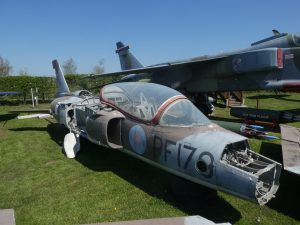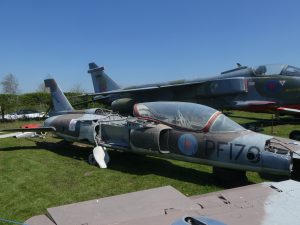Technical Data
Length: 31.75ft
Height: 9.85ft
Wing Span: 24ft
Service Ceiling: 48,000ft
Max Speed: 525kts/0.95mach
Max Weight: 9520lbs
Seating Capacity: 2
Engines: 1x 4,520 lbs Bristol Orpheus 101
Our Aircraft
The Folland Gnat XR541 first flew on 8th July 1963 and served operationally with the RAF until 1978. It served with 4 FTS at RAF Valley and the Central Flying School and also took part in the Finningley Jubilee flypast 1977. The aircraft remained in active service until 7th February 1978 when the aircraft suffered on engine failure on take-off at RAF Mona on Anglesea
It was subsequently used for instructional use and spares finishing her carreer at RAF St. Athan with the Civilian Craft Apprentices School where she was was painted in the camouflage colours with the mock serial of PF179 added, as part of a Painters and Finishers course number.
Disposed of in the 1990s, her history becomes a little unclear – possibly residing with Everetts in Ipswich, then reportedly sold to the USA in 2007 but this probably didn’t happen as Phoenix Aviation based at Bruntingthorpe acquired her in 2010 from Global Aviation at Binbrook. The aircraft was being well looked with the intention to return it to ground running condition. However, before that occured it was sold and moved to North Weald, where it was partially stripped for spares to help keep the Gnat Display Team’s aircraft in the air, and looked rather sad and unloved.
The good news is that the Gnat has now arrived at Bournemouth Aviation Museum and hopefully we can put the aircraft back together again as XR541 and give her a nice new paint job that will do justice to this fine old aircraft.


Type History
The Folland Gnat was a compact swept-wing subsonic fighter aircraft that was developed and built by Folland Aircraft a private British company of the late 1950’s. The initial development aircraft was called the Midge and used an Armstrong Siddeley Viper 101 turbojet engine. Its maiden flight was in August 1954 but unfortunately was destroyed in a crash in September 1955.
The larger Gnat aircraft was being developed at the same time with larger air intakes to suit the more powerful Bristol Siddeley Orpheus engine, a slightly larger wing, and provision for the installation of a 30 mm ADEN cannon in each intake lip. On 18 July 1955 the Folland prototype Gnat first flew from RAF Boscombe Down and six further aircraft were ordered by the Ministry of Supply for evaluation purposes. However, RAF interest cooled for using the Gnat as a fighter and no RAF orders were forthcoming.
However, Folland had identified a potential use for the type as a two-seat trainer aircraft. The aircraft was modified to satisfy the RAF requirements for an advanced two-seat trainer aircraft that could help transition pilots between the de Havilland Vampire T 11 and operational fighters at the time such as the supersonic English Electric Lightning.
Folland proposed the two-seat Gnat Trainer which featured several changes, including the adoption of a new wing with additional fuel capacity, which in turn allowed for more internal space within the fuselage to be allocated for additional equipment. A more powerful variant of the Orpheus engine was also used, while the length of the forward fuselage area was increased, and the tail surfaces enlarged. The inboard ailerons of the fighter variant were reconfigured to an arrangement of outboard ailerons and conventional flaps. On 7 January 1958, an initial contract for 14 pre-production Gnat Trainers was issued.
On 31 August 1959, the prototype Gnat Trainer conducted its maiden flight from Chilbolton airfield, Hampshire. The Ministry did not initially place a production order as they were concerned about the ability of Follands to take on a large order. However, following the take-over of Folland by Hawker Siddeley Aviation (becoming the Hamble division), orders were placed for 30, 20 and 41 trainers between February 1960-March 1962 and given the designation Gnat T Mk. 1.
The first production Gnat T.1s for the Royal Air Force were delivered in February 1962 to the Central Flying School at RAF Little Rissington. The major operator of the type was 4 Flying Training School at RAF Valley, the first aircraft being delivered in November 1962. In 1964, 4 FTS formed the Yellowjacks aerobatic team with very distinctive all-yellow painted Gnats T1s.
However, just one year later the team were reformed as part of the Central Flying School aerobatic team and renamed the Red Arrows with the now famous all red Gnat T1s. On 14 May 1965 the last Royal Air Force Gnat T.1 to be built was delivered to the Red Arrows. The Gnat T1 continued in RAF service until it was eventually retired in November 1978 when it was replaced by the Hawker Siddeley Hawk.
Overseas orders
Although the RAF did not place any orders for the Gnat F1 fighter version, orders were placed by the Air Forces of Finland (13) and Yugoslavia (2). India also placed a large order for the type (175), which included a licence for production by Hindustan Aeronautics Limited (HAL). The first 13 aircraft for the Indian Air Force (IAF) were assembled at Hamble-le-Rice. They were followed by partly completed aircraft as HAL slowly took over production of the aircraft. The first flight of an Indian Air Force Gnat was in the United Kingdom on 11 January 1958 and it was delivered to India and accepted by the Indian Air Force on 30 January 1958. The first HAL aircraft flew in May 1962 and the last Indian-built Gnat F.1 was delivered on 31 January 1974.